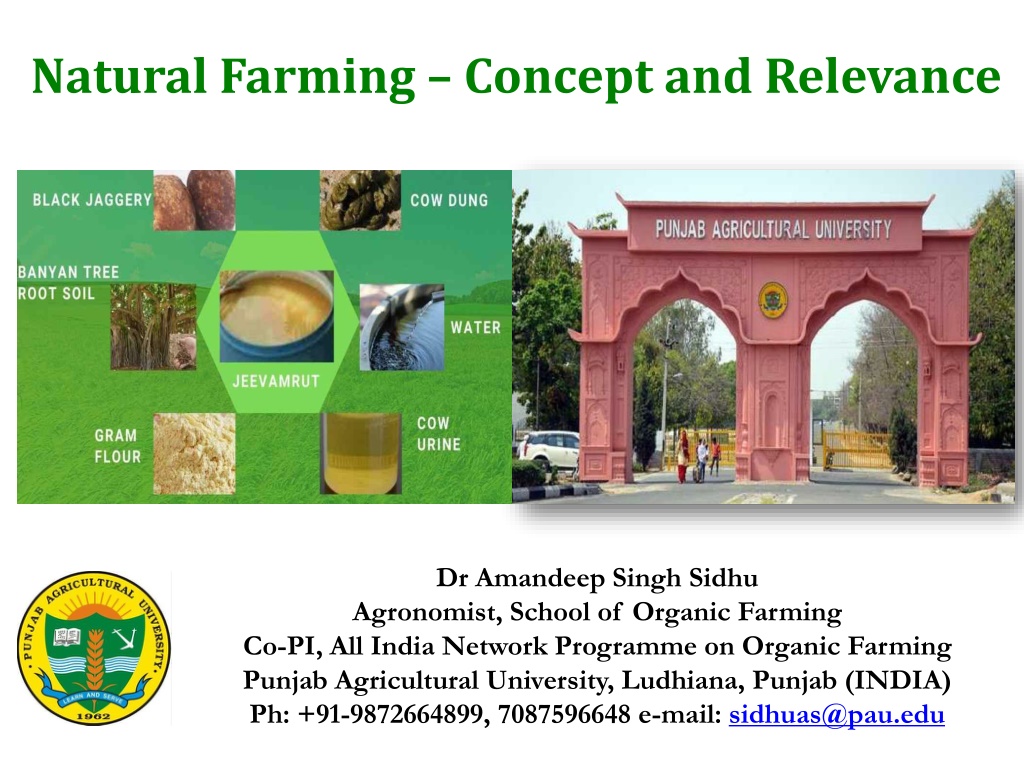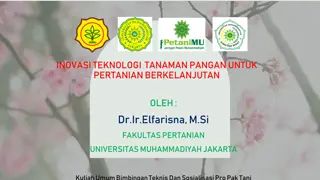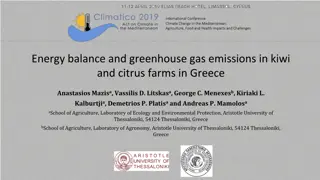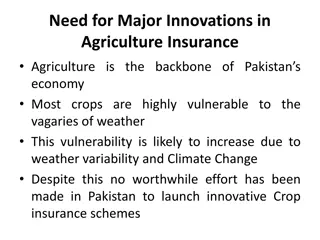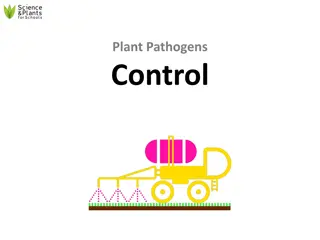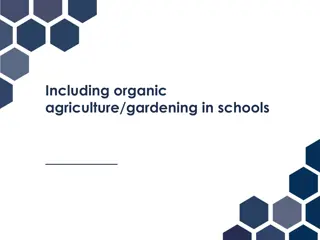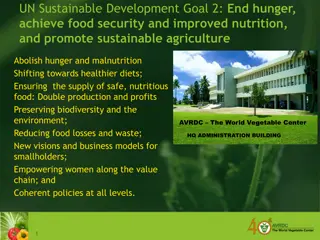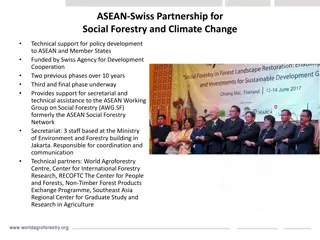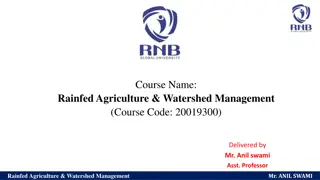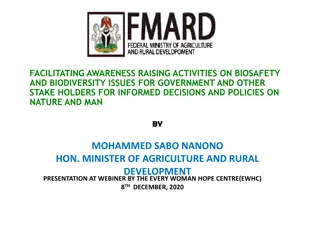Understanding Sustainable Agriculture for a Healthier Future
Sustainable agriculture focuses on integrating plant and animal production practices to meet human needs while enhancing environmental quality. It aims to minimize negative impacts of mass production farming, such as environmental damage and reduced biodiversity, by utilizing natural biological cycles and controls. By adopting sustainable practices, we can safeguard our resources and enhance the quality of life for farmers and society as a whole.
- Sustainable agriculture
- Environmental impact
- Natural farming
- Agricultural practices
- Sustainable development
Download Presentation

Please find below an Image/Link to download the presentation.
The content on the website is provided AS IS for your information and personal use only. It may not be sold, licensed, or shared on other websites without obtaining consent from the author. Download presentation by click this link. If you encounter any issues during the download, it is possible that the publisher has removed the file from their server.
E N D
Presentation Transcript
Natural Farming Concept and Relevance Dr Amandeep Singh Sidhu Agronomist, School of Organic Farming Co-PI, All India Network Programme on Organic Farming Punjab Agricultural University, Ludhiana, Punjab (INDIA) Ph: +91-9872664899, 7087596648 e-mail: sidhuas@pau.edu
Trends The onset of the industrial age brought about various trends that have led us to our present state. The quick rise in population. More people to feed. The greater need for production. Farms required to produce more. The increase in urbanism. Less farms to do more work. Wide-spread ecological impacts. Faith in technological, political and economic fixes. Today, less developed countries are following a similar trend. Many farmers in these countries choose to grow cash crops rather than subsistence crops. Regions reliant upon cash crops tend to develop adverse, long term environmental problems.
Negative Impacts Our current mass production style of farming has resulted in numerous negative side-affects: Environmental damages Reduced biodiversity Habitat destruction Deforestation Water, air and soil pollution Salinization, desertification Decline in water resources and land subsidence Human impacts Farm land destruction Damage to soil fertility Reduced nutritional value of food Decreased economic, social and cultural values For the past several years research has looked at sustainable agriculture as a potential solution to correct and prevent these problems.
Defined Sustainable agriculture was addressed by Congress in the Food, Agriculture, Conservation, and Trade Act of 1990. Under that law, the term sustainable agriculture means an integrated system of plant and animal production practices having a site-specific application that will, over the long term: satisfy human food and fiber needs enhance environmental quality and the natural resource base upon which the agricultural economy depends make the most efficient use of non-renewable resources and on-farm resources and integrate, where appropriate, natural biological cycles and controls sustain the economic viability of farm operations enhance the quality of life for farmers and society as a whole."
Goal The goal of sustainable agriculture is to minimize adverse impacts to the immediate and off-farm environments while providing a sustained level of production and profit. Inherent to this goal is the understanding that sustainability must be extended not only globally, but indefinitely in time, and to all living organisms including humans. Simply stated, sustainable agriculture refers to the ability of a farm to produce food indefinitely, without causing irreversible damage to ecosystem health.
Rules and Regulations While the goal of sustainable agriculture is similarly defined by numerous organizations, there are no strictly defined rules or regulations for farmers to abide by. There are standards and certifications for organic farming, which has similarities to sustainable agriculture, but the two not synonymous.
Organic vs. Sustainable Organic farming excludes the use of synthetic inputs, such as synthetic fertilizers, pesticides, herbicides, and GMOs, whereas sustainable agriculture does not. Sustainability aims to balance between what is taken out of the soil with what is returned to it, without relying on outside inputs. This is not necessarily a concern of organic farming. Organic farms constitute only a small percent of farms with a minor impact on the environment. Sustainable agriculture aims to make positive changes on all farms. In the future, large organic farms that rely on machinery and automation, and purchased inputs, will have similar sustainability issues that large conventional farms do today.
Forms of Bharatiya Prakritik Krishi Paddhati (BPKP) 1. Organic farming / Jaivik Kheti / Jaivik Krishi Avoiding or largely excluding synthetics in farming Meets International Standards 1.6 % area of net cultivated area (2020) to 4 % by 2025 Rs 4500 crores worth products are exported 2. Natural farming Use of locally prepared cow based products (Beejamrit, Jeevamrit, Ghanjeevamrit & others), Acchdhana, Whapasa and intercropping Jeevamrit to ensure high soil biological activity Recycling of biomass, diversified crop stand, cattle urine and slurry 3. Biodynamic farming Making life giving compost from dead material Cowpat pit manures such as BD-500 to 507
Forms of Bharatiya Prakritik Krishi Paddhati (BPKP) 4. Rishi krishi Drawn from Vedas 15 kg/ha of virgin rhizopheric soil from banyan tree Amritpani (ghee, cowdung, honey, water) and virgin soil Beej sanskar (seed treatment), Bhumi sanskar (soil application) and Padap sanskar (foliar spray) Chickpea 5. Panchagavya krishi Prepared from five products of cow: dung, urine, milk, curd and ghee Enrichment of soil, induce plant vigour with quality production Urdbean 6. Natueco farming Neighborhood Resource Enrichment' by `Additive Regeneration' rather than through dependence on external, commercial inputs. Soil Enrichment, Roots - Development and Canopy - management Mungbean Pigeonpea Sesame Horsegram Sword bean Ragi
Forms of Bharatiya Prakritik Krishi Paddhati (BPKP) 7. Homa farming You heal the atmosphere, and the healed atmosphere will heal you Spiritual practice that dates from the Vedic period Ash that results from the puja is used to energise composts, plants, animals etc 8. Permaculture / eco-agriculture Agro-ecological principles Earthworm and soil bio-diversity development Sustainability Science led promotion of different forms of BPKP (Natural Farming) including Organic Farming is essential
ICAR-All India Network Programme on Organic Farming (AI-NPOF) 2003-04 (13 centres) 2015-16 (20 centres) 16 states 11 SAU s 7 ICAR institutes 1 Special Heritage University 10 ACZ s 12 AERs Proposed to be upgraded in the next SFC AICRP on Organic and Natural Farming 35 centres including 8 out-reach centres 24 States 17 SAUs, 8 ICAR institutes, 1 CAU & 3 other institutions
NATURAL FARMING The agronomic phrase NaturalFarming refers to farming with nature Emphasis is on enhanced soil quality and physical conditions by managing organic matter and soil biological activity diversified crops & cropping systems enhanced biomass recycling biological interactions It is an attempt to reproduce natural conditions by encouraging integration of crops and livestock so that synergistic effects of different components of the integrated farming system are efficiently and beneficially used
Natural Farming is referred to as the natural way of farming, or do nothing farming, or the Fukuoka Method. An ecological farming approach introduced in the 1975 book The One-Straw Revolution by Japanese farmer Masanobu Fukuoka. Natural farming is a subset of organic farming that includes concepts and principles from agroecology, agroforestry, ecoagriculture and permaculture. Natural farming is a closed system that demands no external inputs and closely mimics the natural ecosystem balance. sustainable agriculture,
It advocate complete elimination of synthetic external inputs (fertilizers and pesticides) instead encourage application of natural formulations and concoctions prepared from on-farm ingredients Promotion of agronomic practices such as reduced tillage; trenching, cover crops, crop rotations, crop residue mulching, intercropping systems, minimal irrigation, coated seeds Catalysing soil microorganisms to build the fertility of the soil and finally enhance ecosystem services through nutrient cycling, conservation of top soil, increasing water retention, biological N fixation Natural regulation of pests & diseases Biodiversity sustainability of agroecosystems conservation contributing towards the
Zero Budget Natural Farming Subhas Palekar, 2005-06 Four key elements: Beejamrita-seed treatment, Jevamrita- fermented Achhadana- mulching, and irrigations. For small scale operations. Partial food security. Mixed use in Punjab. Mixed results microbial culture, Waaphasa; no
COMPARISON OF CONVENTIONAL, ORGANIC AND NATURAL FARMING PRACTICES S. No. 1. Characteristics Conventional Organic Natural Farming Seeds HYV, hybrids and GMO HYV and hybrids Preferably indigenous and local varieties Polycultures with 8 20 crops including agro-forestry Reduced tillage adapted Crops cropping systems Tillage and 2. Predominantly monoculture Diversified system cropping 3. Deep tillage Deep conservation tillage Bio-control agents tillage and Seed treatment Fungicides, 4. Beejamrutha insecticides bio-control agents INM, fertilizers, organic and green manures, bio-fertilizers and legume crops and Nutrient management 5. Synthetic Organic manures, compost, non-edible oil cakes, bio-fertilizers, legume crops and bio- dynamic formulations and green enriched Jeevamrutha legume crops and
S. No. Characteristics Conventional Organic Natural Farming Cultural Mechanical, solarisation, Stale seed bed etc Bio-pesticides, based formulation, plant based extract, pest repellent crops, sticky traps, light traps, pheromone traps and inter-cultivation practices and Soil Integrated managment herbicides weed and Weed management No recommendation specific 6 . neem Integrated disease Cultural, Mechanical, Biological, Chemical pest and Brahmstra, Neemastra, Agniastra, dung+urine, buttermilk management- Plant protection 7 . cow Sore and Climate, soil and plant based method, Use of sensors, Mobile Apps, Satellite imaging Irrigation in noon hours (Whapahasa) without scientific basis Fixed variable critical growth stages interval depth and and Irrigation scheduling 8 . any Irrigation methods 10. Water use Surface, Sprinkler and Drip Medium to high Surface, Sprinkler and Drip Medium to high 9 . Alternate furrows No evidence scientific
S. No. Characteristics Conventional Organic Natural Farming Low yields to comparable Low yield in control experiments Crop yield 11. Higher yields Produce quality 12. Moderate to high High quality produce No scientific evidence Medium farmers survey Low to medium based on farmers survey based on Input costs 13. High Medium to high Net returns 14. Moderate to high Moderate to high Low depending on crops and farm operations viz: transplanting, harvesting etc to medium High owing to manual and cultural management No recommendation specific Labour costs 15. weed Vulnerable owing to relatively low yields particularly in initial year of conversion Highly vulnerable due to marked reduction Available, affordable and accessible foods Food security 16. yield Occasional presence of residues on agri- produce and water bodies Pesticides residues Safe, nutritious food healthy and 17. No specific standards
S. No. Characteristics Conventional Organic Natural Farming Pesticides exposure Nutrient leaching Carbon sequestration 18. High Low Low No scientific evidence No scientific evidence 19. Medium to high Medium 20. High Moderate Unit Area basis- High Unit Area basis-Low Greenhouse gases No scientific evidence 21. Unit Yield basis- Low Low to medium microbial activity Unit Yield basis- High No scientific evidence No scientific evidence Standards: formulated so far Soil life 22. High microbial activity Climate resilience 23. Medium to high High Not Standards- Minimum residue limit Agri- commodities Exports (2020- 21) Standards- standards NPOP 24. Area & value: No valid reported data Value- 7078.49 crores Value-2.74 Crores Lakh
PRESENT STATUS OF NATURAL FARMING IN INDIA Natural farming movement led by farmers and civil society has spread to states such as Karnataka, Tamil Nadu, Maharashtra among others in the last few decades. Chemical-free agriculture, popularly known as organic agriculture, has been gaining importance in India since 2000. The NITI Aayog has also emphasized on naturalfarming . However, community organization and farmers use organic and natural farming terms interchangeably. It is roughly estimated that around 2.5 million farmers in India are practicing regenerative agriculture. In the next 5 years, it is expected to reach 20 lakh hectares- in any form of organic farming, including natural farming, of which 12 lakh hectares are under Bharatiya Prakritik Krishi Padhati (BPKP). States such as Andhra Pradesh, Himachal Pradesh, Gujarat, Haryana, Karnataka and Kerala are promoting natural farming. Andhra Pradesh is the front runner among all states in implementing natural farming programme at a mass scale
Karnataka recently initiated implementation of zero budget natural farming (ZBNF) on a pilot basis in 2,000 hectares in each of the 10 agro-climatic zones of the state. Himachal Pradesh has also set an ambitious target of promoting natural farming in entire state by 2022. It has claimed to exceed its targets of year 2019 by covering more than 50,000 farmer familie Kerala, Gujarat, Haryana and Rajasthan have conducted multiple mass level awareness programmes, trainings and workshops for hundreds and thousands of farmers to promote natural farming. As per 17th Loksabha standing committee on agriculture report dated March, 2020, The Ministry of Agriculture and Farmers Welfare (MoAFW) proposed Bhartiya Prakritik Krishi Padhati (BPKP) as a new sub-mission under Paramparagat Krishi Vikas Yojna (PKVY).
KEY CHALLENGES TO SCALE-UP NATURAL FARMING IN INDIA Limited buy-in from line ministries and wider research ecosystem Limited awareness among farmers Lack of enabling production and marketing ecosystem Limited safety nets and incentives to enable the transition
Jeevamrit Take plastic drum of 250 litres capacity add 10 kg of fresh cow (indigenous) dung + 10 litres of indigenous cow urine + 2 kg of Jaggary + 2 kg of pulse flour (Basan, Chickpea flour) + 150 g of soil from undisturbed bunds or forest or under tree cover in 200 litres of water mix thoroughly Keep the drum in shade covering with gunny bag or cotton cloth or plastic mosquito net Stir the mixture for 5-10 minutes for twice a day (morning and evening) with wooden stick Jeevamrit is ready for application at 9th day It can be applied up to 12th day from its preparation.
THANK YOU EAT ORGANIC DREAM ORGANIC LIVE ORGANIC
